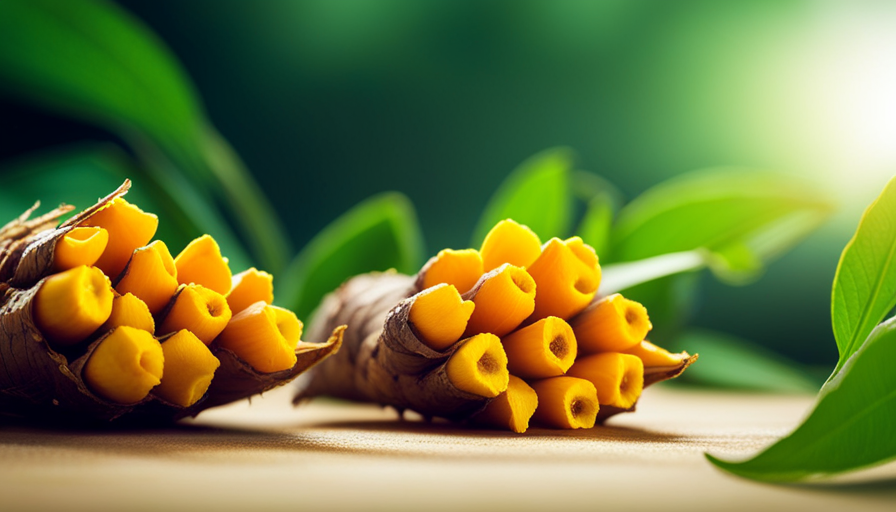Do you like to sip on a hot cup of tea when it’s cold outside? Have you considered trying turmeric tea? This zesty and tasty beverage has been increasing in popularity lately, all thanks to its various health advantages.
But do you put milk in turmeric tea? That’s a question that many people ask, and the answer isn’t as straightforward as you might think.
Turmeric tea is made by boiling turmeric root or powder in water and adding other ingredients such as ginger, honey, and lemon. It’s a natural remedy that has been used in Ayurvedic medicine for centuries to treat various ailments such as inflammation, digestive issues, and skin problems.
Turmeric contains curcumin, a compound that has antioxidant and anti-inflammatory properties, making it an excellent addition to your diet. But whether you should add milk to your turmeric tea is a matter of personal preference and depends on several factors.
In this article, we’ll explore the benefits and drawbacks of adding milk to turmeric tea and provide you with alternative options to consider.
Key Takeaways
- Adding milk to turmeric tea is a matter of personal preference and can depend on several factors.
- Milk may decrease absorption of curcumin, but some studies show it can increase bioavailability.
- Adding fat to turmeric tea can increase bioavailability, and adding black pepper can also enhance taste and bioavailability.
- Plant-based alternatives like coconut, almond, soy, cashew, or oat milk can be used instead of regular milk in turmeric tea.
What is Turmeric Tea?
If you’ve never tried turmeric tea before, you should know that it’s a delicious and healthy beverage that’s easy to make at home. Turmeric tea is made by steeping turmeric root or powder in hot water.
There are many different recipes for turmeric tea, but most include other ingredients like ginger, lemon, honey, or cinnamon. Some people also like to add milk or coconut milk to their turmeric tea to make it creamier and richer.
Turmeric tea is known for its many health benefits. Turmeric contains a compound called curcumin, which has anti-inflammatory and antioxidant properties. Drinking turmeric tea regularly may help reduce inflammation in the body, boost the immune system, and improve brain function.
Additionally, turmeric tea may help lower the risk of chronic diseases like heart disease, diabetes, and cancer.
In the next section, we’ll dive deeper into the benefits of turmeric tea.
The Benefits of Turmeric Tea
Turmeric tea has been compared to a superhero, with its anti-inflammatory properties acting as a shield against chronic diseases. With its main active ingredient, curcumin, turmeric has been shown to have a range of health benefits that make it a popular choice in traditional medicine practices.
A quick search online will yield countless recipes for turmeric tea, each boasting different flavors and health benefits. However, the benefits of turmeric tea go beyond just its taste. Take a look at the table below to see just a few of the many benefits of drinking turmeric tea regularly.
| Benefit | Description |
|---|---|
| Anti-inflammatory | Can help reduce inflammation in the body, which is linked to chronic diseases like arthritis, heart disease, and cancer. |
| Antioxidant | Contains compounds that can protect your cells from damage caused by free radicals. |
| Digestive aid | Can help improve digestion and reduce symptoms of digestive issues like bloating and gas. |
| Immune booster | Contains compounds that can help boost your immune system and fight off infections. |
Now, let’s move on to the question of whether or not you should put milk in your turmeric tea.
Milk in Turmeric Tea
Adding a creamy touch to your golden elixir can turn your cup of turmeric tea into a cozy, comforting experience. While some people prefer to enjoy their turmeric tea with just a dash of honey, others like to add a splash of milk for a creamier texture. If you’re looking for a vegan option, there are plenty of milk alternatives available that can give you the same creamy result without the dairy.
When it comes to adding milk to your turmeric tea, there are a few things to keep in mind. First, it’s important to note that adding milk may decrease the absorption of the turmeric’s active ingredient, curcumin. However, some studies have shown that adding milk to turmeric can increase the bioavailability of curcumin. So, whether or not to add milk to your turmeric tea is ultimately a personal preference.
In the next section, we’ll delve into the science behind adding milk to your turmeric tea.
The Science Behind Adding Milk
If you’re wondering about adding milk to your turmeric tea, understanding the science behind it might help. One key point to consider is the curcumin in turmeric, which is known for its health benefits but is also poorly absorbed by the body.
Adding milk to your tea could increase the bioavailability of curcumin, allowing your body to better absorb it. The fat in milk also plays a role in this process, but there are other factors to consider as well, such as the amount of turmeric used and the type of milk added.
Curcumin and Bioavailability
You might think that adding milk to your turmeric tea won’t make a difference in its health benefits, but curcumin, the active ingredient in turmeric, has low bioavailability and requires certain compounds to enhance its absorption.
Curcumin absorption is limited by its poor solubility in water and its rapid metabolism and elimination. However, studies suggest that the addition of piperine, a compound found in black pepper, can increase curcumin absorption by up to 2,000%.
Other compounds, such as quercetin, found in fruits and vegetables, and resveratrol, present in red wine, have also been shown to enhance curcumin absorption. While turmeric supplements often contain piperine to enhance curcumin absorption, adding a small amount of milk to your turmeric tea may also increase its bioavailability.
The role of fat in curcumin absorption has been studied, and it has been shown that the presence of fat can increase curcumin absorption. Milk contains fat, which may explain why adding it to turmeric tea can enhance curcumin absorption. However, more research is needed to determine the optimal amount of milk to add and whether other factors, such as the temperature of the tea, can affect curcumin bioavailability.
The Role of Fat
Now that you understand the relationship between curcumin and bioavailability, let’s talk about the role of fat in turmeric tea. Adding fat to your turmeric tea may increase the bioavailability of curcumin in your body.
This is because curcumin is fat-soluble, which means it needs to be dissolved in fat in order to be absorbed by your body. Without fat, much of the curcumin passes through your digestive system and is excreted from your body.
The importance of fat in turmeric tea cannot be overstated. Without it, you may be missing out on the many benefits of curcumin. A comparison of fat-free turmeric tea to one that contains fat shows that the latter is more effective in increasing the bioavailability of curcumin.
So, if you want to get the most out of your turmeric tea, consider adding a source of fat, such as coconut milk or ghee. With this knowledge in mind, let’s move on to other factors that can affect the bioavailability of curcumin in turmeric tea.
Other Factors
Let’s explore some other factors that can impact the bioavailability of curcumin in your turmeric tea. One of the most significant factors is the flavor combinations you choose. Curcumin is fat-soluble, so it needs to bind to fat molecules to be absorbed by your body. If you’re drinking turmeric tea without any fat, you’re not getting the full benefits of the curcumin. Adding milk or coconut oil to your turmeric tea can increase its bioavailability significantly.
Another factor that can impact the bioavailability of curcumin in your turmeric tea is the brewing technique you use. To get the most out of your turmeric tea, you should simmer it for at least ten minutes. This will help to extract the curcumin from the turmeric root. It’s also a good idea to add black pepper to your turmeric tea. Black pepper contains piperine, which has been shown to increase the bioavailability of curcumin by up to 2,000%.
With these tips in mind, you can ensure that you’re getting the most out of your turmeric tea. Adding milk has its own benefits, which we’ll explore in the next section.
Pros of Adding Milk
When it comes to adding milk to your turmeric tea, there are a few pros to keep in mind. First and foremost, adding milk can enhance the taste and texture of your drink, making it creamier and smoother.
Additionally, milk can add nutritional value to your turmeric tea, as it’s a good source of calcium and vitamin D.
Finally, adding milk is a traditional preparation method for turmeric tea in certain cultures, so it can be a way to honor those traditions and add authenticity to your drink.
Taste and Texture
Sipping on turmeric tea with a splash of milk may add a creamy and comforting texture to the warm brew. Texture preference is subjective, so if you prefer a smoother and richer consistency, adding milk might be the way to go. However, if you’re lactose intolerant or simply avoiding dairy, there are several milk substitutes that can still enhance the taste and texture of your turmeric tea, such as almond milk, coconut milk, or oat milk.
It’s worth noting that while milk can improve the texture of turmeric tea, it may also slightly alter the taste. Milk has a natural sweetness and can tone down the spiciness of the turmeric, making the tea milder and more palatable for some. Others may prefer the bold and slightly bitter flavor of turmeric tea without any milk.
Regardless of your preference, adding milk can be a simple and tasty way to enjoy this golden elixir. Speaking of taste, let’s now delve into the nutritional value of turmeric tea.
Nutritional Value
Now that you’ve learned about the texture and taste preferences of turmeric tea, it’s time to explore its nutritional value. Turmeric tea is known for its anti-inflammatory properties, which can help reduce joint pain and swelling. In addition, it is a good source of antioxidants that protect against cell damage and can boost the immune system.
If you want to add extra nutrients to your turmeric tea, you can try making turmeric milk. This is a popular option for vegans, as it provides a creamy texture without using dairy. Turmeric milk is made by combining turmeric powder with a non-dairy milk, such as almond or coconut milk, and heating it up on the stove. The result is a warm and comforting drink that is packed with even more nutritional benefits.
As you can see, turmeric tea is not only delicious but also has many health benefits. In the next section, we will explore the traditional preparation of turmeric tea.
Traditional Preparation
To get the full flavor and aroma of turmeric tea, it’s best to let the tea steep for at least five minutes, allowing the spices to infuse the water with their warm and inviting essence. Traditional methods of preparing turmeric tea involve boiling water and adding grated or powdered turmeric, ginger, black pepper, and honey, then straining the mixture before serving. This method has cultural significance in many parts of the world, where turmeric tea is believed to have healing properties and is often used as a natural remedy for inflammation and colds.
If you’re looking to prepare turmeric tea in the traditional way, here are a few tips to keep in mind:
- Use fresh turmeric root or high-quality powdered turmeric for the best flavor and nutritional benefits.
- Add a pinch of black pepper to boost the absorption of curcumin, the active ingredient in turmeric.
- Sweeten the tea with honey or maple syrup instead of sugar for a healthier option.
- Experiment with adding other spices like cinnamon or cardamom for a unique twist.
- Strain the tea before serving to remove any bits of ginger or turmeric that may have settled at the bottom.
Next, let’s explore the cons of adding milk to your turmeric tea.
Cons of Adding Milk
Adding milk to turmeric tea may actually decrease the absorption of certain beneficial compounds in the tea. Turmeric contains a compound called curcumin, which has anti-inflammatory and antioxidant properties. When curcumin is consumed with black pepper, which contains piperine, the absorption of curcumin is increased.
However, when milk is added to turmeric tea, the casein protein in milk binds with curcumin, making it less available for absorption. Therefore, adding milk to turmeric tea may actually decrease the potential health benefits of the tea.
Although adding milk to turmeric tea is a common cultural practice, there are alternatives to milk that can be used to enhance the absorption of curcumin. For example, coconut milk, almond milk, or soy milk can be used instead of regular milk. These milk alternatives do not contain casein protein and may not interfere with the absorption of curcumin.
Additionally, adding a pinch of black pepper to turmeric tea can further enhance the absorption of curcumin. Overall, if you want to enjoy the potential health benefits of turmeric tea, it may be best to avoid adding regular milk and instead try using a milk alternative or adding black pepper.
Alternatives to Milk
If you’re looking for a way to enhance the absorption of curcumin in your turmeric tea, try using plant-based alternatives to milk. Dairy-free options like coconut milk or almond milk can work just as well. Not only do these alternatives contain healthy fats that can aid in the absorption of curcumin, but they also add a delicious and creamy flavor to your tea.
Here are some other plant-based alternatives to milk to try in your turmeric tea:
-
Cashew Milk: Rich and creamy, cashew milk is a great option for those who want a nutty flavor in their tea.
-
Oat Milk: Made from whole oats, this milk alternative has a slightly sweet flavor that can complement the earthy taste of turmeric.
-
Hemp Milk: Packed with omega-3 fatty acids, hemp milk can provide a boost to your immune system while also adding a nutty flavor to your tea.
-
Soy Milk: High in protein and low in fat, soy milk is a great option for those who are looking to lower their cholesterol levels.
These plant-based alternatives to milk can offer a healthier and more flavorful option for your turmeric tea. However, if you prefer to use milk in your tea, there are ways to do so without compromising the benefits of curcumin.
Let’s explore how to make turmeric tea with milk in the next section.
How to Make Turmeric Tea with Milk
When preparing your turmeric-infused beverage, you may consider using milk as a dairy substitute to pair with the spice. Milk, whether it’s cow’s milk or a non-dairy alternative, can add a creamy texture to the tea and help increase the bioavailability of curcumin.
Other spice alternatives that can be added to turmeric tea include cinnamon, ginger, and black pepper. These spices not only enhance the flavor of the tea but also offer additional health benefits.
To make turmeric tea with milk, start by brewing a pot of water on the stove. Once the water’s boiled, add in a teaspoon of turmeric and any other spices you wish to include. Let the tea simmer for 5-10 minutes before adding in your desired amount of milk.
Heat the tea and milk mixture until it’s warm, then strain out any remaining spices and enjoy. However, if you prefer to make turmeric tea without milk, there are still plenty of brewing techniques to explore.
How to Make Turmeric Tea without Milk
Looking for a dairy-free alternative to your turmeric tea? Try this simple recipe for a no milk turmeric tea that’s both flavorful and healthy.
To make this dairy-free recipe, you’ll need a few simple ingredients such as turmeric powder, fresh ginger, cinnamon, honey, and water.
First, add one teaspoon of turmeric powder and one teaspoon of grated ginger to a saucepan with two cups of water. Bring the mixture to a boil, then reduce the heat and simmer for five minutes.
After that, add half a teaspoon of cinnamon and a tablespoon of honey, and stir well. Pour the mixture into a mug, and enjoy your dairy-free and vegan turmeric tea recipe.
You can also add a slice of lemon or a pinch of black pepper for an extra flavor boost.
Frequently Asked Questions
What are the different types of turmeric tea?
Turmeric tea comes in various types, including turmeric latte and turmeric ginger tea. Each type has unique ingredients and benefits, such as reducing inflammation and boosting immunity. Try them all to find your favorite!
Can turmeric tea be consumed during pregnancy?
Turmeric tea can be safely consumed during pregnancy, as long as it’s in moderation. In fact, it’s considered to be helpful for morning sickness and fertility. However, it’s important to consult with your healthcare provider before adding turmeric tea to your diet.
Is it safe to drink turmeric tea every day?
You may have heard that drinking turmeric tea every day is beneficial, and research suggests this is true. It can boost immunity, reduce inflammation, and aid digestion. To make it without milk, simply steep turmeric in hot water with honey and lemon.
What are the potential side effects of adding milk to turmeric tea?
Adding milk to turmeric tea may cause curdling and potentially unpleasant taste. For those with lactose intolerance, it could lead to digestive discomfort. No major side effects have been reported.
Can turmeric tea help with weight loss?
Boost your metabolism and aid digestion with turmeric tea. Studies suggest it may aid in weight loss by reducing inflammation and regulating blood sugar levels. Milk may hinder these benefits.
Conclusion
So, do you put milk in turmeric tea? The answer is up to you! Adding milk to turmeric tea has been a longstanding tradition in many cultures, and it can provide additional health benefits and a creamy flavor.
However, some people prefer to enjoy their turmeric tea without milk. If you do choose to add milk to your turmeric tea, the science behind it suggests that it can increase the absorption of the tea’s anti-inflammatory and antioxidant properties. However, it’s important to note that adding milk can also decrease the absorption of some of the compounds in turmeric, so it’s not always the best choice.
If you’re looking for an alternative to milk, you can try using coconut milk, almond milk, or even honey. And whether you choose to add milk or not, making turmeric tea is a simple and easy way to incorporate this powerful spice into your daily routine.
So go ahead, give it a try and see how it can benefit your health! After all, the possibilities are as endless as the health benefits – you might just end up feeling like a superhero after drinking it!










